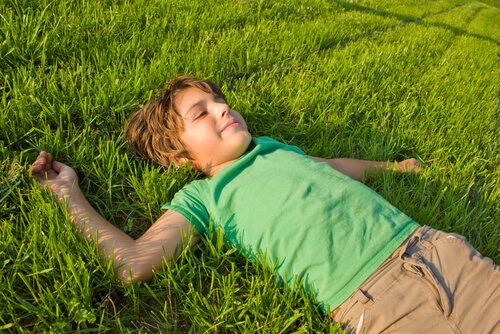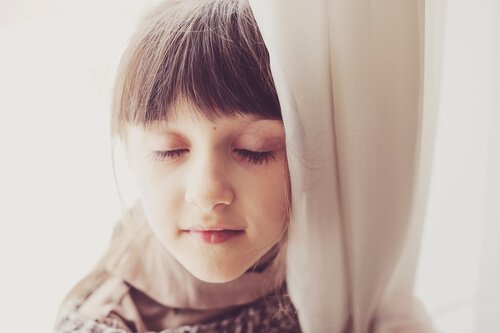Relaxation Exercises for Children

Play is an integral part of a child’s development. Children have to run, jump, dance, move, and get into things. That being said, sometimes they need to relax and be calm. In this article, we will share with you relaxation exercises for children that will benefit their physical and mental health alike.
If you teach children these techniques, they will be empowered to lower their own anxiety, stress, and insomnia. They will also be able to control their emotions and behavior better. Plus, the exercises can improve their mood. Best of all, we don’t get them in this relaxed, calm state out of boredom. Welcome to fun relaxation!
Jacobson and Schultz methods
The Jacobson method is one of the most popular in the world. The technique involves the contraction and subsequent relaxation of different muscles or muscle groups.
It’s quite simple. While lying on the floor, tell the child to tense up and then release different parts of their body. The child should notice a progressive release spreading through their whole body. You can start with individual muscle groups like the hand or the neck. With practice, you can make it progressively more difficult.

The Schultz Method is an autogenic relaxation exercise suitable for children over six. Schultz divided the method into two levels: upper and lower. It is based on the sensations of weight and heat.
While lying on the floor, ask the child to concentrate on the parts of their body that seem to weigh more (legs or arms) and that feel the warmest. Once the child senses a change and feels like they are free of tension and weight, do the same with the upper body. Continue like this until all the muscles are relaxed.
To make it easier for the child to follow the instructions, you can suggest that they think of being like a robot. As such, they have to move in a very stiff and robotic way. Then, to relax, they turn into a rag doll, with a soft body free of any muscular tension.
The Game of Rejoue
Rejoue is one of the most fun techniques. In French, rejoue means “replay.” Let’s do it!
This method says that the essence of life is made up of pairs of opposites. So we have hot-cold, day-night, up-down, black-white, activity-rest, etc. The rejoue technique brings together relaxation exercises for children based on these pairs.
To do this, the game uses a lot of rocking, which is supposed to imitate the movement of a rocking chair. So the child uses almost all of their muscle groups to rock forward, backward, to one side, and then the other.
This duality comes into play when the child has to tense up some parts of their body but soften and relax others. They will only be able to rock effectively if their body relaxes enough.
Another game is stretching. It teaches small children to differentiate between the sensations of stretching and relaxing. For example, you would ask the child to open up their arms and stretch them out to the sides as much as possible. They should stay in that position for a few seconds. Then, ask them to slowly relax. They will feel a tingling sensation after doing it a few times.
Activities with friends
Sometimes kids chase each other around and it’s hard to calm them down. It’s also much harder for them to concentrate and focus after so much excitement. Here, you can try the feather duster activity.
It’s a very simple activity to do. Put some relaxing music on in the background and divide the group of kids into pairs. One child should lie on the ground, while the other child uses a feather to play along with the music on their partner’s body. Then, they switch positions.
There’s another activity similar to this that involves a soft ball. It is also done in pairs. One child lays on the ground with their eyes closed. The other massages their partner’s body with a small, soft ball, as if they were applying soap.
Visualizing pleasant images
If there is one area that children are very good at, it is imagination. They are so free-thinking and we can use that to help them relax. One good way to soothe them is through visualization.
Tell the child to lay on the floor and concentrate on their breathing for a few minutes. Next, ask them to focus on what we’ll be saying out loud. Ask them to imagine a big, peaceful field. The grass in this field is perfectly cut. Tell them to smell the field, to hear the birds singing or feel the texture of the flowers.

Visualization is very versatile. You can personalize it with whatever landscapes you like: the beach, the mountains, or you could even talk about smells. As you can see, the possibilities are limited only by your imagination. The main goal is to help kids have fun while they are relaxing.
In other words, do it in such a way that they don’t think of it as work. To do that, one important thing is make sure that the adults are properly modeling behavior for the children. Remember that imitation is an important way that children learn new things.
One last note: these relaxation exercises for children can also work for adults. After all, it’s good to stay young at heart!
Play is an integral part of a child’s development. Children have to run, jump, dance, move, and get into things. That being said, sometimes they need to relax and be calm. In this article, we will share with you relaxation exercises for children that will benefit their physical and mental health alike.
If you teach children these techniques, they will be empowered to lower their own anxiety, stress, and insomnia. They will also be able to control their emotions and behavior better. Plus, the exercises can improve their mood. Best of all, we don’t get them in this relaxed, calm state out of boredom. Welcome to fun relaxation!
Jacobson and Schultz methods
The Jacobson method is one of the most popular in the world. The technique involves the contraction and subsequent relaxation of different muscles or muscle groups.
It’s quite simple. While lying on the floor, tell the child to tense up and then release different parts of their body. The child should notice a progressive release spreading through their whole body. You can start with individual muscle groups like the hand or the neck. With practice, you can make it progressively more difficult.

The Schultz Method is an autogenic relaxation exercise suitable for children over six. Schultz divided the method into two levels: upper and lower. It is based on the sensations of weight and heat.
While lying on the floor, ask the child to concentrate on the parts of their body that seem to weigh more (legs or arms) and that feel the warmest. Once the child senses a change and feels like they are free of tension and weight, do the same with the upper body. Continue like this until all the muscles are relaxed.
To make it easier for the child to follow the instructions, you can suggest that they think of being like a robot. As such, they have to move in a very stiff and robotic way. Then, to relax, they turn into a rag doll, with a soft body free of any muscular tension.
The Game of Rejoue
Rejoue is one of the most fun techniques. In French, rejoue means “replay.” Let’s do it!
This method says that the essence of life is made up of pairs of opposites. So we have hot-cold, day-night, up-down, black-white, activity-rest, etc. The rejoue technique brings together relaxation exercises for children based on these pairs.
To do this, the game uses a lot of rocking, which is supposed to imitate the movement of a rocking chair. So the child uses almost all of their muscle groups to rock forward, backward, to one side, and then the other.
This duality comes into play when the child has to tense up some parts of their body but soften and relax others. They will only be able to rock effectively if their body relaxes enough.
Another game is stretching. It teaches small children to differentiate between the sensations of stretching and relaxing. For example, you would ask the child to open up their arms and stretch them out to the sides as much as possible. They should stay in that position for a few seconds. Then, ask them to slowly relax. They will feel a tingling sensation after doing it a few times.
Activities with friends
Sometimes kids chase each other around and it’s hard to calm them down. It’s also much harder for them to concentrate and focus after so much excitement. Here, you can try the feather duster activity.
It’s a very simple activity to do. Put some relaxing music on in the background and divide the group of kids into pairs. One child should lie on the ground, while the other child uses a feather to play along with the music on their partner’s body. Then, they switch positions.
There’s another activity similar to this that involves a soft ball. It is also done in pairs. One child lays on the ground with their eyes closed. The other massages their partner’s body with a small, soft ball, as if they were applying soap.
Visualizing pleasant images
If there is one area that children are very good at, it is imagination. They are so free-thinking and we can use that to help them relax. One good way to soothe them is through visualization.
Tell the child to lay on the floor and concentrate on their breathing for a few minutes. Next, ask them to focus on what we’ll be saying out loud. Ask them to imagine a big, peaceful field. The grass in this field is perfectly cut. Tell them to smell the field, to hear the birds singing or feel the texture of the flowers.

Visualization is very versatile. You can personalize it with whatever landscapes you like: the beach, the mountains, or you could even talk about smells. As you can see, the possibilities are limited only by your imagination. The main goal is to help kids have fun while they are relaxing.
In other words, do it in such a way that they don’t think of it as work. To do that, one important thing is make sure that the adults are properly modeling behavior for the children. Remember that imitation is an important way that children learn new things.
One last note: these relaxation exercises for children can also work for adults. After all, it’s good to stay young at heart!
This text is provided for informational purposes only and does not replace consultation with a professional. If in doubt, consult your specialist.







